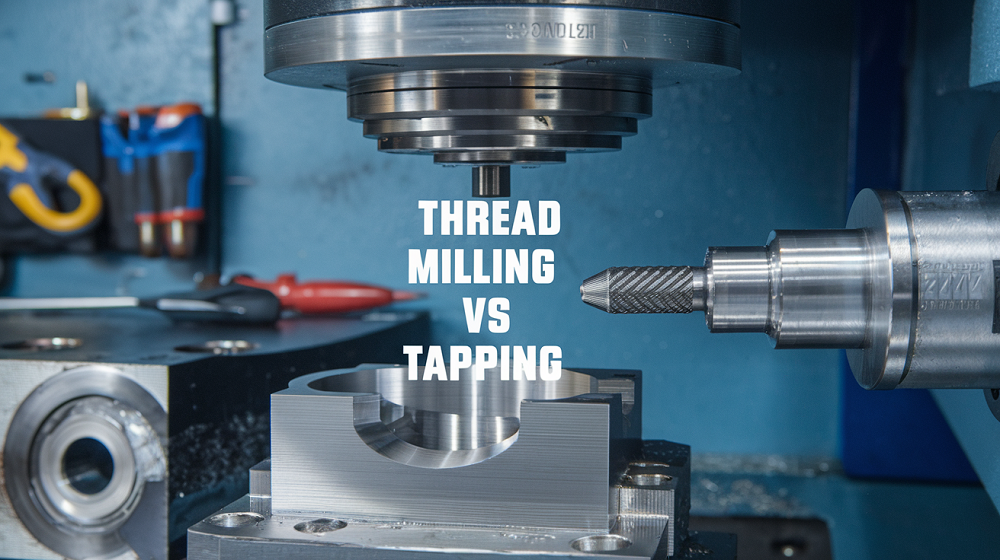Thread milling and tapping are 2 extensively utilized machining procedures for creating interior strings in various products, each offering distinctive advantages and negative aspects that make them suitable for various applications. Thread milling is a multi-tooth milling operation that involves utilizing a revolving tool to cut strings right into the work surface. Because thread milling utilizes a round activity incorporated with linear feed, it enables for the development of strings in materials that are hard or breakable, which would otherwise be challenging for tapping procedures.
With tapping, any type of misalignment during the threading process can result in damaged threads or even damaged taps, which can be expensive in terms of both time and sources. In comparison, thread milling decreases the chance of such concerns due to its lowered reducing pressures and boosted adaptability, permitting for less complicated device course changes in multi-axis CNC makers. Thread milling can generate strings with higher accuracy and much better surface finishes, which is commonly vital in high-precision applications such as aerospace and medical device manufacturing.
Discover thread milling vs tapping the crucial distinctions in between thread milling and tapping, 2 crucial machining processes for internal thread creation, to establish one of the most appropriate method for your projects.
On the contrary, thread milling demands a various setup, usually utilizing a CNC milling machine and particularly created thread mill cutters. While thread milling tools can be extra costly upfront due to their intricacy and style, the longevity and adaptability frequently counter the first investment. Thread mills can be made use of to produce a selection of thread sizes, while faucets have a tendency to be more application-specific, calling for additional supply and maintenance prices.
When choosing in between tapping and thread milling, Tool life is another important factor to take into consideration. Taps, specifically when used in more challenging materials, can put on down quickly, demanding frequent substitutes. This continuous need for brand-new taps can pump up operational expenses, especially in high-volume production settings. On the other hand, thread mills, with their multi-point design, normally exhibit long term tool life, specifically in challenging products. Additionally, thread milling can fit deeper strings, which advantages the machining of blind holes where tapping might not provide the exact same outcomes. The threading depth for faucet applications is frequently restricted, whereas thread milling can exceed these restrictions, adding further to its flexibility.

An additional consideration when choosing between thread milling and tapping is the aspect of threading tolerance. Thread milling allows for tighter tolerances, provided its capacity to readjust feed prices and the quality of the produced thread forms.
In several instances, the choice to utilize either thread milling or tapping might come down to the certain application at hand. If a maker needs to create a highly accurate thread in a custom dimension and form within a hard material, thread milling would likely be the a lot more proper option.
Thread milling systems often tend to create less scrap product contrasted to tapping, which can result in lower waste and an extra lasting production procedure. Furthermore, thread milling operations usually need less power consumption over time, specifically in high-production atmospheres where tool life and performance are important elements for success.
Thread milling typically supplies enhanced safety and security, as the style and procedure of milling tools minimize the likelihood of such sudden failings. CNC milling devices usually have built-in security features that additionally minimize risks linked with tooling, providing a regulated setting that can be important in making certain the safety of drivers.
As companies progressively make every effort to boost manufacturing processes and outputs, recognizing the details of both thread milling and tapping offers a beneficial opportunity for organizations to enhance their procedures. While tapping might offer an effective option in specific situations, particularly for standard strings in softer products, thread milling confirms advantageous in settings that need adaptability, accuracy, and the capacity to function with a range of materials.
Finally, the option in between thread milling and tapping expands past mere preference; it encompasses a broad range of aspects consisting of product residential or commercial properties, thread specs, and general production objectives. By recognizing the toughness and limitations of each technique, machinists and engineers can better adapt their techniques, thus improving effectiveness and making sure ideal end results in their tasks. Whether via tapping or thread milling, the best purpose continues to be the very same: to attain high-quality threaded features that meet the stringent demands of modern manufacturing while considering cost-effectiveness and production sustainability. As technology remains to advance, the landscape of thread generation will unquestionably advance, with developments in tooling and machining techniques allowing even greater precision, efficiency, and adaptability in future production procedures.
Comments on “Environmental Sustainability in Thread Milling: Reducing Waste and Energy Consumption”